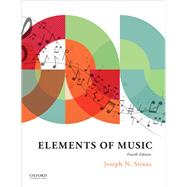
Elements of Music
by Straus, Joseph N.Buy New
Rent Textbook
Rent Digital
Downloadable: 180 Days
Downloadable: 365 Days
Downloadable: Lifetime Access
Used Textbook
We're Sorry
Sold Out
This item is being sold by an Individual Seller and will not ship from the Online Bookstore's warehouse. The Seller must confirm the order within two business days. If the Seller refuses to sell or fails to confirm within this time frame, then the order is cancelled.
Please be sure to read the Description offered by the Seller.
Summary
Author Biography
Joseph N. Straus is a Distinguished Professor of Music Theory at the City of New York Graduate Center.
Table of Contents
Preface
Acknowledgments
Chapter 1 Pitch
Lesson 1: Staff
The five-line staff, pitches and notes, noteheads, ascending and descending motion,
steps and leaps, ledger lines
Lesson 2: Keyboard
Piano keyboard, black and white keys, letter names for notes, steps and leaps, octaves, piano fingering
Lesson 3: Treble clef
Treble clef, accidentals (sharp, flat, and natural), semitones, enharmonic equivalence
Lesson 4: Bass clef
Bass clef, accidentals (sharp, flat, natural), semitones
Lesson 5: Great staff
Great staff
Chapter 1: Supplementary Lesson
Alto clef, tenor clef, octave signs (8va and 8vb), octave designations, double flats, and double sharps
Chapter 1: Self-Test
Chapter 2 Rhythm and Meter
Lesson 6: Quarter notes, half notes, and whole notes in 4/4 meter
Quarter notes, half notes, whole notes, stems, beats, measures (bars) and barlines, meter ("common time"), upbeat, downbeat, accent, conducting patterns, tempo
Lesson 7: Eighth notes and sixteenth notes
Eighth notes and sixteenth notes, flags, beams
Lesson 8: Dots and ties
Augmentation dot, dotted rhythms, ties, anacrusis
Lesson 9: Rests
Rests
Lesson 10: Duple meter
2/4 and 2/2 meter, upbeat, downbeat, conducting patterns
Lesson 11: Triple meter
3/4 meter and its conducting pattern
Lesson 12: Compound meter
Compound meter, 6/8 meter, and its conducting pattern
Lesson 13: Syncopation
Syncopation, accent marks, ties, and subdivision
Chapter 2: Supplementary Lesson
Stem direction, anacrusis, rhythmic values smaller than a sixteenth note, triplets, other duple, triple, and quadruple meters
Chapter 2: Self-Test
Chapter 3 Major and Minor Scales
Lesson 14: Major scale (C major)
Major scale, arrangement of semitones and whole tones, scale-degree numbers, scale-degree names, solf?ge syllables
Lesson 15: Major scales other than C major
Transposition, major scales with sharps, major scales with flats, circle of fifths
Lesson 16: Major keys and key signatures
Major keys and key signatures
Lesson 17: Minor scale (A minor)
Minor scale, arrangement of semitones and whole tones, scale-degree numbers, scale-degree names, solf?ge syllables, and raising scale-degrees
Lesson 18: Minor scales other than A minor
Transposition, minor scales with sharps, minor scales with flats, circle of fifths
Lesson 19: Minor keys and key signatures
Minor keys, minor key signatures, relative keys, parallel keys
Lesson 20: Harmonic and melodic minor
Harmonic minor and melodic minor scales
Chapter 3: Supplementary Lesson
Modes and the pentatonic scale
Chapter 3: Self-Test
Chapter 4 Intervals
Lesson 21: Interval size
Intervals, melodic and harmonic intervals, interval size, compound intervals
Lesson 22: Seconds and thirds
Interval quality, natural intervals, major and minor intervals, diminished and augmented intervals, enharmonically equivalent intervals
Lesson 23: Sixths and Sevenths
Sixths and sevenths, enharmonically equivalent intervals, interval inversion
Lesson 24: Fourths and fifths, unisons and octaves
Perfect intervals, fourths and fifths, unisons and octaves, interval inversion, enharmonically equivalent intervals
Lesson 25: Intervals in a major key
Intervals in a major key, intervals and scale degrees, consonance and dissonance
Lesson 26: Intervals in a minor key
Intervals in a minor key, intervals and scale degrees
Chapter 4: Supplementary Lesson
All intervals, doubly diminished and doubly augmented intervals, intervals in harmonic and melodic minor
Chapter 4: Self-Test
Chapter 5 Triads and Seventh Chords
Lesson 27: Triads
Triads (root, third, and fifth), triad qualities (major, minor, diminished, augmented), natural triads, chord symbols
Lesson 28: Triads in inversion
Soprano and bass, inversion of triads (root position, first inversion, second inversion), figured bass ( , , )
Lesson 29: Triads in major keys
Triad names, Roman numerals, triad qualities in major keys
Lesson 30: Triads in minor keys
Triad names, Roman numerals, triad qualities in minor keys, and the effect of raising the leading tone
Lesson 31: Seventh chords
Seventh chords, major-minor (dominant) seventh chords, inversions of seventh chords, dominant seventh chords in major and minor keys, figured bass symbols, chord names
Chapter 5: Supplementary Lesson
Qualities of seventh chords, natural seventh chords, inversions of seventh chords, and seventh chords in major and minor keys
Chapter 5: Self-Test
Chapter 6 Harmony and Form
Lesson 32: Tonic and dominant
Harmonic progression, tonic harmony, dominant and dominant seventh harmonies, harmonizing a melody
Lesson 33: Extending a harmonic progression
Dominant preparation chords (ii and IV), preceding a dominant preparation chord (vi), and moving directly from IV to I
Lesson 34: Phrase and cadence
Phrase, authentic cadence, half cadence, and plagal cadence
Lesson 35: Form
Combining four-measure phrases into longer groupings (eight-, twelve-, and sixteen-measure periods) and song forms (A-B-A and A-A-B-A)
Chapter 6: Supplementary Lesson
Nonharmonic tones, doubling, tendency tones, voice-leading smoothness, and parallel fifths and octaves
Glossary
An electronic version of this book is available through VitalSource.
This book is viewable on PC, Mac, iPhone, iPad, iPod Touch, and most smartphones.
By purchasing, you will be able to view this book online, as well as download it, for the chosen number of days.
A downloadable version of this book is available through the eCampus Reader or compatible Adobe readers.
Applications are available on iOS, Android, PC, Mac, and Windows Mobile platforms.
Please view the compatibility matrix prior to purchase.
